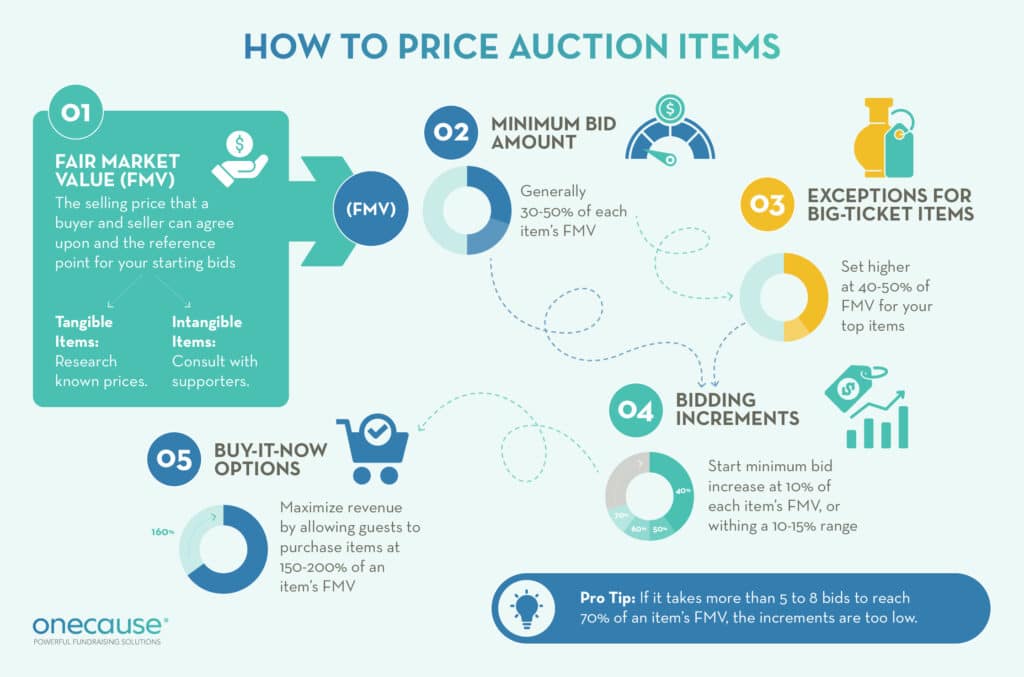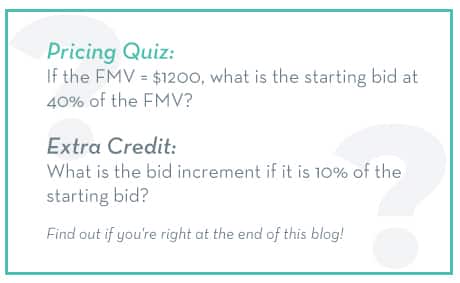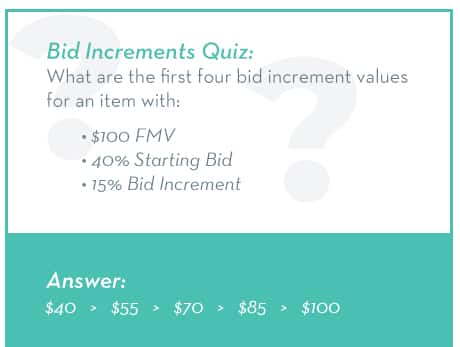How to Price Silent Auction Items (& Raise More) in 5 Steps
After item procurement, pricing your silent auction items is an important next step. Your organization’s goal is to strike the right balance – attracting more supporters while encouraging higher bids in your silent auction.
Pricing silent auction items involves a mix of math and market research, but it doesn’t have to be daunting. We’re here to help make the process easier! Our guide breaks it down into 5 simple steps to help you price auction items with confidence. Let’s dive in!
Quick Overview: The Art of Auction Item Pricing
Finding the right approach to pricing your items will build your auction’s momentum to secure the highest bids possible.
You can easily price your items by understanding:
- Fair market value (FMV)
- Minimum bid amount
- Exceptions for big-ticket items
- Bidding increments
- Buy-it-Now options
Let’s walk through the details of each step.

Step 1: Estimate Your Item’s Fair Market Value (FMV).
Determining the FMV is the most complex yet crucial first step in pricing items. Fair market value (FMV) is the selling price that a buyer and seller can agree upon. In silent auctions, it is typically the reference point for a starting bid.
While there are several ways to estimate FMV, each method requires careful evaluation to ensure donors feel item pricing reflects true worth.
Research the Known Price of Tangible Items
Tangible items are easier to assign an FMV to because they have standard retail prices. For example, the FMV of AirPods or a $100 restaurant gift certificate would be their retail value.
Sports memorabilia, autographed items, and other items that carry unique value can be a little more difficult to assess and require more research to estimate.
Good sources to help establish FMV include:
- eBay. Find almost any item on sale on one of the largest online marketplaces to determine the common value of an item.
- Item donors. The people who donated the item to your silent auction can give you context of the value and estimated FMV. But keep in mind, some item donors may overestimate the value if they have an emotional attachment to that item.
- Other silent auctions. Look at silent auctions that are like yours and evaluate how they priced their silent auction items. They may not be the same, but you could see some overlap that makes sense for your pricing strategy.
Consult with Supporters to Estimate the Value of Intangible Items
When requesting donations and writing silent auction letter requests, it’s important to keep a good mix of tangible and intangible items to maximize appeal and bids.
Intangible items include things like:
- Travel packages
- Exclusive VIP access
- Year-long membership
- Once-in-a-lifetime experiences
While each intangible item may be perceived differently by your audience, the more thoughtfully you estimate an item’s worth, the better chance you have for a successful silent auction.
Consider these factors when trying to determine FMV for intangible items:
- Audience demographics. You know your audience best! Make sure you take into account age, income, gender, family life, religion, etc.
- Previous event interest. Look to your past to influence the decision of FMV for your intangible items. Look at which items did well and how you can replicate (and improve) similar items in your next silent auction.
- Consult with fellow fundraisers and supporters. Think of your go-to fundraiser friend or most loyal supporter. Ask them their opinion! Pricing silent auction items is important, so get all the feedback you can.
Once the fair market value for all your silent auction items are established, you’re ready to determine their starting points and bid increments to prepare your auction for success.
Step 2: Set a Minimum Bid at 30-50% of the Item’s FMV.
The key to encouraging auction participation lies in setting an appealing starting bid. Typically, this is set to 30% to 50% of the item’s FMV to attract initial bidders.
A starting bid can be dependent on:
- Audience demographics
- Bargain donor mentality
- Popularity of the item
- Donor loyalty to your mission
- Emotion behind an item
For less popular items, aim for the lower end (30%), while setting starting bids for more unique items to 50% of their FMV to better reflect their value and attract serious bidders.
Step 3: Set a Higher Minimum Bid for Big-Ticket Items.
While the general rule is to set starting bids at 30-50% of FMV, popular, high-demand items are the exception. These items often drive significant revenue, so setting a higher minimum bid of 40-50% of FMV is ideal to capitalize on their excitement.
For example, school auctions typically see greater bidder engagement with something as simple as parking spots. Knowing which items sell best will help you determine if you should set a higher starting bid – and continue to raise it year-over-year.
Follow these tips to highlight big-ticket items and maximize proceeds for your mission:
- Strategize item procurement. Plan your item procurement accordingly to avoid overwhelming your auction with less exciting items that could divert attention from your high-value items, maximizing both interest and bids.
- Optimize display. Effectively highlight your silent auction’s exclusive items using display cases, spotlights, pedestals, fabric, or music to draw attention to their appeal.
- Announce unique items. Promote unique items on social media before the auction. On event night, have your auctioneer drive bidding and increase engagement for these standout items.
- Use text messaging. Send real-time notifications to keep supporters informed. Alert bidders when the auction is live, when they’ve been outbid, or when items sell out. The possibilities with mobile bidding are endless.
The more carefully you set your initial bid, the better you’ll be at building the right bidding momentum for your auction. With these unique and popular items, it’s important to make sure all your auction rules are clearly spelled out so that when the bidding frenzy begins, it’s fair game!
Step 4: Set Bidding Increments at 10% of the Item’s FMV.
The general recommendation is to start by increasing bids by 10% of the item’s FMV. However, there may be situations that allow for some flexibility, so increments of 10-15% of FMV are considered reasonable.
To effectively strategize pricing and bidding increments for your silent auction, consider the following:
- Look to past events. Review year-over-year data to refine your pricing strategy, for example, if an item performed well in the past and a similar item is featured this year, increase the bid increment to 15% of its FMV.
- Rethink pricier items. Maintain bidding increments at 10% for items with a higher FMV to prevent them from growing too large and discouraging bidding.
- Make the bid increment visible. Display the bid increment on paper bid sheets so bidders know how much to increase their bid. With mobile bidding, the system automatically enforces the established increment.
- Round to a whole number. Make it easy on you and your guests and round the bid increment to the nearest whole number. Your bidders will thank you!
A good ratio helps keep bidders engaged, driving up the value of the items. Small increments can disrupt the bidding momentum and prevent items from reaching their full potential. For instance, if it takes more than 5-8 bids to reach 70% of the FMV for an item, your bid increments are likely too low.
Step 5: Offer a Buy-It-Now Option at 150-200% of the FMV.
A “Buy-It-Now” option is a great addition to your silent auction pricing strategy. It allows bidders to purchase an item immediately at a premium price, helping ensure more items exceed their FMV when bidding closes.
It’s best to offer a “Buy-it-Now” option at 150-200% of the item’s FMV to help the item sell quickly. When other bidders see a desirable item being sold immediately, the sense of scarcity influences them to increase their bids on different items. But be careful! This option should be used strategically to ensure that natural bidding never exceeds the “Buy-it-Now” price.
The “Buy-it-Now” option isn’t ideal for every item, including:
- Items with high emotional appeal
- Unique or one-of-a-kind items
- Experiences you can’t find anywhere else
- Items that have started bidding wars in the past
Remember, the “Buy-it-Now” option can boost your auction’s success, but it’s important to use it wisely to prevent undervaluing items.
Time to Start Pricing Your Silent Auction Items!
With effective bidding increments, you’ll attract higher interest and offer a positive experience for bidders to support your mission. Partner with dedicated auction software, like OneCause, to optimize your organization’s resources and save up to 8 hours of planning. From item procurement to auction close, OneCause offers powerful tools to streamline every phase of your auction.
Explore other resources to strengthen your fundraising strategy:
- 6 Essential Silent Auction Rules for Your Best Auction Yet: Rock your next auction with these best practices designed to help you raise more.
- Silent Auction Rules Template: Implement clear rules for your silent auction with this template, covering everything from bidder registration to checkout procedures.
- 20 Premier Silent Auction Software Solutions to Grow Revenue: Explore the top silent auction software and support tools that can take your event to the next level
- How to Plan a Silent Auction: The Ultimate Guide for Success: Create the perfect event that will raise funds, drive deeper engagement, and further your mission.





